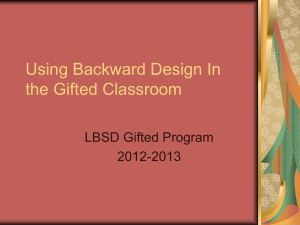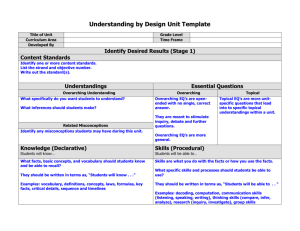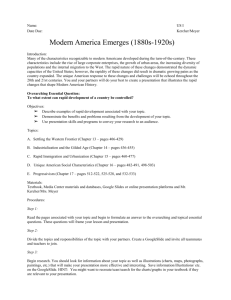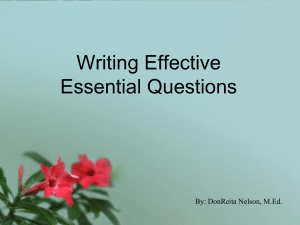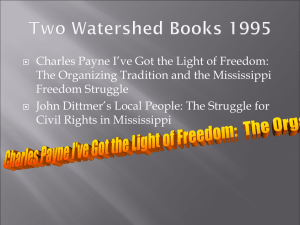2011TheRoots ftheStrugglforEqualityandJustice.doc
advertisement
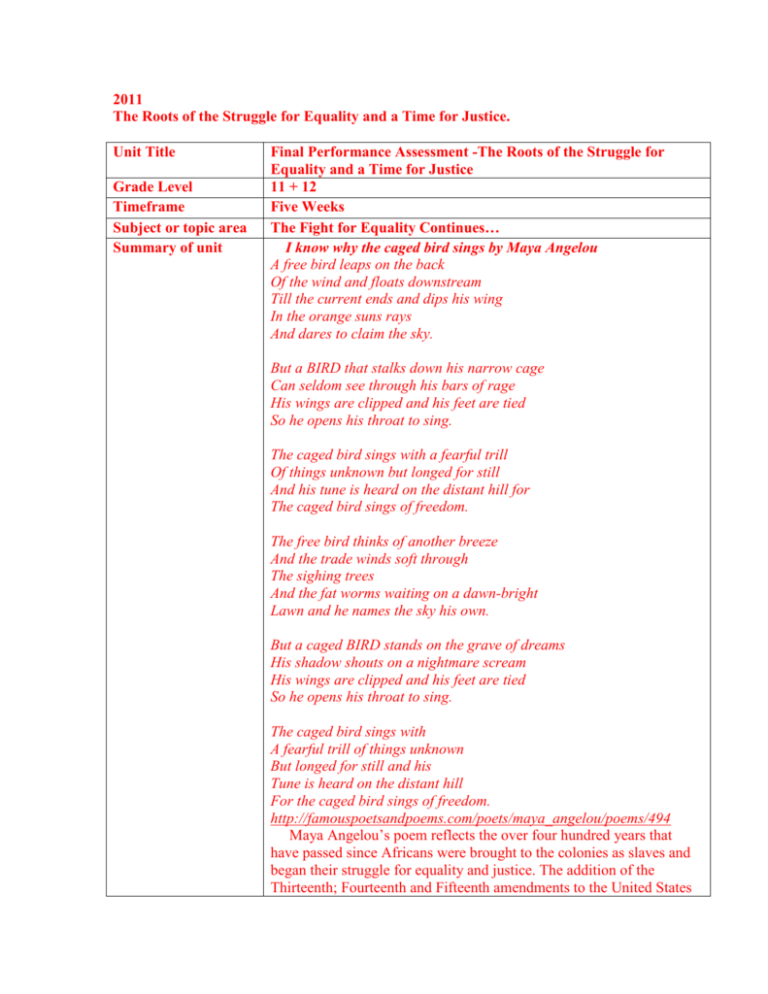
2011 The Roots of the Struggle for Equality and a Time for Justice. Unit Title Grade Level Timeframe Subject or topic area Summary of unit Final Performance Assessment -The Roots of the Struggle for Equality and a Time for Justice 11 + 12 Five Weeks The Fight for Equality Continues… I know why the caged bird sings by Maya Angelou A free bird leaps on the back Of the wind and floats downstream Till the current ends and dips his wing In the orange suns rays And dares to claim the sky. But a BIRD that stalks down his narrow cage Can seldom see through his bars of rage His wings are clipped and his feet are tied So he opens his throat to sing. The caged bird sings with a fearful trill Of things unknown but longed for still And his tune is heard on the distant hill for The caged bird sings of freedom. The free bird thinks of another breeze And the trade winds soft through The sighing trees And the fat worms waiting on a dawn-bright Lawn and he names the sky his own. But a caged BIRD stands on the grave of dreams His shadow shouts on a nightmare scream His wings are clipped and his feet are tied So he opens his throat to sing. The caged bird sings with A fearful trill of things unknown But longed for still and his Tune is heard on the distant hill For the caged bird sings of freedom. http://famouspoetsandpoems.com/poets/maya_angelou/poems/494 Maya Angelou’s poem reflects the over four hundred years that have passed since Africans were brought to the colonies as slaves and began their struggle for equality and justice. The addition of the Thirteenth; Fourteenth and Fifteenth amendments to the United States Constitution; the 1954 Supreme Court Decision Brown v. Board of Education; Topeka, Kansas; Rosa Parks refusing to give up her seat on a bus in Montgomery, Alabama; the March on Washington, the Civil Rights Act of 1964, Voting Rights Act of 1965, the murders of Malcolm X, Medgar Evers and Reverend King along with many others and Judge Garrity’s 1974 court order mandating busing in Boston, the Million Man March, Thurgood Marshall, Clarence Thomas and the struggle for freedom and equality still continues. Students will be provided the opportunity to study the World War Two Era and the seeds of the second revolution in America where equality was not a reality for African Americans and understand the meaning of Civil rights: the nonpolitical rights of a citizen; the rights of personal, liberty guaranteed to United States citizens by the Thirteenth and Fourteenth amendments to the Constitution and by acts of Congress, and Civil disobedience: refusal to obey governmental demands or commands especially as a nonviolent and collective means of forcing concessions from the government. The fight was waged by blacks and whites in the streets and churches, the courts and schools of the American south, later in the northern cities and spread across the country. It was a struggle for racial integration and attainment of equal rights that altered the fabric of American life and whose reverberations continue to this day. Students will embark on a historical journey of the Civil Rights Movement and its legacy by reading The Other American – The African American by Robert E. Walsh and Leon Burrell, and Through White Eyes: Color and Racism in Vermont by Robert E. Walsh, and meet the people who shaped America’s future, experience the events, fears and triumphs of the times. Students will experience the struggles and the influence of people such as Thurgood Marshall, Morris Dees, the Tuskegee Airmen, Rosa Parks and Carl Brashear in visual and literal texts such as the Eyes on the Prize series, Tuskegee Airmen, Men of Honor, Ghosts of Mississippi and Separate but Equal on the Civil Rights Movement. Students will make clear connections to the Five Big Ideasgeography/environment, politics, economics, social/cultural and science/technology and the unit’s Overarching/Essential and Topical Questions. Overarching/Essential African American Studies Overarching/Essential QuestionsQuestions 1. What is the meaning of having an enduring understanding of what you learn and how does this affect concept of identity in a culture? (6.1, 6.4, 6.9, 6.12, 6.13,6.1.6) 2. From whose perspective or angle are you seeing, reading and/or hearing from? (6.2, 6.4, 6.12, 6.13, 6.16) 3. Whose story is it? (6.2, 6.4, 6.13) Topical Questions 1. How did the World War Two military experience affect Established Goals: (Grade Cluster Expectations (GCEs) and Standards) African-American soldier’s expectations when they returned to the United States? 2. How did the Cold War shape American society ion the 1950s? 3. How did the white southerners’ strategy of massive resistance affect the modern civil rights movement? 4. Why did many African Americans become more militant during the 1960s? e.g., Vietnam War 5. How did the Black Power movement stimulate black culture? 6. What is police profiling and how did it affect African Americans, e.g., Rodney King episode? 7. Why were African Americans so supportive of Bill Clinton’s presidency and attached to the Democratic Party? 8. What explains African American’s growing economic prosperity? 9. Why has black identity become more complicated at the dawn of the 21st century? 10. What were the accomplishments of the Second Wave of Feminism and what role did African American play in the movement? 11. Why is President Obama’s election important in American history? 6.1 Causes and Effects in Human Societies: 6.2 Uses of Evidence and data History: 6.4 Historical Connections. 6.7 Geographical Knowledge 6.9 Meaning of Citizenship: 6.12 Human Rights Economics: 6.16 Impact of Economic Systems: Vital Results: 1.8 Reports 1.19 Research 1.21 Selection 1.22 Simulation and Modeling 2.1 Types of Questions 3.3 Respect 3.10 Teamwork 3.11 Interactions 4.1 Service 4.2 Democratic Processes 4.3 Cultural Expressions 4.4 Effects of Prejudice 4.5 Continuity and Change Introductory Activities Enabling Activities Performance Tasks 1. Students are given the Theme, Topic, and Purpose of the Unit, Standards, Overarching/Essential and Topical Questions, the Five Big Ideas and the unit Performance Assessment. 2. Cooperative groups will participate in an ABCD activity reflecting their prior knowledge of the modern African American Civil Rights Movement and share in class. 3. Students will participate in writing activities, e.g., Frame Questions, Comparison/Contrast, Exit Cards, Student Response Logs, Dialectical Journal, free writes, Analogy Exit Card and journals relating to the visual and literal texts, the Five Big Ideasgeography/environment, politics, economics, social/cultural and science/technology and the unit’s Overarching/Essential and Topical Questions to be placed in their portfolio. 4. Students will refer to the documentary Ethnic Notions and evaluate the visual texts, effects of media messages demonstrating understanding of the historical eras, styles, images and evolving technologies that helped define the struggle for attainment of civil rights. They will analyze the connections of Unit One’s What’s in a Word Activity to the Overarching/Essential and Topical Questions. They will share their results with their peers in class. 1. Students will complete written response pieces to various visual texts, e.g., The Diary of Miss Jane Pittman, Eyes on the Prize documentary, Separate But Equal, Men of Honor, Mississippi Burning and the Ghosts of Mississippi making clear connections to the Overarching/Essential and Topical Questions and the Five Big Ideas. 2. Students will choose a person involved in the struggle for civil rights, conduct research using literary and technological sources, complete a written and creative piece and present it to their peers. 3. Students will read literal texts, e.g., Black Like Me by John Howard Griffin, Free At Last, Southern Poverty Law Center, The Other America, the African American Experience by Robert Walsh and Leon Burrell and Through White Eyes by Robert Walsh and connect to Overarching/Essential and Topical Questions and the Five Big Ideas. 4. Students will maintain an electronic portfolio of their work and self-assessments. Final Performance Assessment – Constructed Response, Poster and Verbal Response The Roots of the Struggle for Equality and a Time for Justice PART 1- Students will write a Constructed Response using the given prompt connecting to one Overarching/Essential Question of their choice integrating the Five Big Ideas demonstrating their knowledge of the institution of slavery based on their readings including direct quotations. Prompt- President Obama (Source: 2007 Democratic Primary Debate at Howard University Jun 28, 2007) Q: Is race still the most intractable issue in America? A: [Those who worked on civil rights in the past realized that] to achieve racial equality was not simply good for African-Americans, but it was good for America as a whole; that we could not be what we might be as a nation unless we healed the brutal wounds of slavery and Jim Crow. Now, we have made enormous progress, but the progress we have made is not good enough. As many have already mentioned, we live in a society that remains separated in terms of life opportunities for African-Americans, for Latinos, and the rest of the nation. And it is absolutely critical for us to recognize that there are going to be responsibilities on the part of African-Americans and other groups to take personal responsibility to rise up out of the problems that we face. But there has also got to be a social responsibility, there has to be a sense of mutual responsibility, and there’s got to be political will in the White House to make that happen. http://www.ontheissues.org/2008/Barack_Obama_Civil_Rights.htm PART 2- Individual students will create an originally designed Poster of visual images (if you use any image other than your own you must cite all sources, e.g., photographer’s name) including symbols, words and colors clearly reflecting their Constructed Response and present their work verbally to the class. You are required to complete the writing and peer review process in order to receive credit First draft Rewrite Second draft Rewrite Peer evaluation Final copy –word-processed Times Roman 12, double –spaced You must meet all due dates All components of the writing/peer review process must be handed in on time to receive full credit. A completed self-reflection is required in order to receive credit. Rubrics must be completed with written reasons for your choice of placement Part 3 – Verbal Presentation to your peers. Final Performance Assessment Constructed Response - The Roots of the Struggle for Equality and a Time for Justice 4 - Above 3 - Meets 2 – Approaching 1 Below Category Standards Standards Standards Standards The thesis The thesis The thesis The thesis Focus or statement names statement names statement statement does Thesis the topic of the the constructed outlines some or not name the Statement constructed response of the all of the main topic AND does response and essay. points to be not preview what outlines the main discussed but will be discussed. points to be does not address discussed. the topic Support for Position Includes 4+ or more pieces of evidence Includes 3 or more Includes 2 pieces Includes 1 or pieces of evidence of evidence fewer pieces of evidence Evidence and Examples All of the evidence and examples are specific, relevant and explanations are given that show how each piece of evidence supports the author's position. Most of the evidence and examples are specific, relevant and explanations are given that show how each piece of evidence supports the author's position. At least one of the pieces of evidence and examples is relevant and has an explanation that shows how that piece of evidence supports the author's position. Evidence and examples are NOT relevant AND/OR are not explained. Accuracy All supportive facts and statistics are reported accurately. Almost all supportive facts and statistics are reported accurately. Most supportive facts and statistics are reported accurately. Most supportive facts and statistics were inaccurately reported. Transitions A variety of thoughtful transitions are used. They clearly show how ideas are connected Transitions show how ideas are connected, but there is little variety Some transitions work well, but some connections between ideas are fuzzy. The transitions between ideas are unclear OR nonexistent. Closing Paragraph The conclusion is strong and leaves the reader solidly understanding the writer's position. The conclusion is recognizable. The author's position is restated within the first two sentences of the closing The author's position is restated within the closing paragraph, but not near the There is no conclusion - the paper just ends. Effective paragraph. restatement of the position statement begins the closing paragraph. beginning. Sentence Structure All sentences are well-constructed with varied structure. Most sentences are well constructed, but there is no variation is structure. Most sentences are not wellconstructed or varied. Grammar & Spelling Author makes no Author makes 1-2 errors in errors in grammar grammar or or spelling. spelling Author makes 34 errors in grammar or spelling Author makes more than 4 errors in grammar or spelling Author makes a few errors in capitalization and/or Author makes several errors in capitalization and/or punctuation. Capitalization Author makes no & Punctuation errors in capitalization or punctuation Most sentences are well-constructed and there is some varied sentence structure in the essay. Author makes 1-2 errors in capitalization or punctuation Verbal Presentation Final Performance Assessment The Roots of the Struggle for Equality and a Time for Justice CATEGORY 4 3 2 Student The student is somewhat Preparedness Student is demonstrates demonstrates prepared, but it is clear that clear knowledge and rehearsal was lacking as well knowledge of for the most as clear understanding of the the topic and is part addresses topic in depth. completely the topic in prepared and depth, mostly has obviously prepared but practiced needed more rehearsals for presentation. 1 Student is not well prepared to present and does not clearly understand the topic in depth. Time-Limit Presentation is 6 or more minutes long. Presentation is Presentation is 4 minutes 5 minutes long. long. Presentation 3 minutes or less. Speaks Clearly Speaks clearly and distinctly all the time, and mispronounces Speaks clearly and distinctly all the time, but mispronounces Often mumbles or can not be understood Speaks clearly and distinctly most of the time. Mispronounces no more than one word. no words. one word. and mispronounces words. Vocabulary Uses vocabulary appropriate for the audience. Extends audience vocabulary by defining words that might be new to most of the audience. Uses vocabulary appropriate for the audience. Includes 1-2 words that might be new to most of the audience, but does not define them. Uses vocabulary appropriate for the audience. Does not include any vocabulary that might be new to the audience. Uses several (5 or more) words or phrases that are not understood by the audience. Uses Complete Sentences Always Mostly Sometimes Rarely Original Creative Poster -The Roots of the Struggle for Equality and a Time for Justice. CATEGORY 4 3 2 1 Most of the visual’s Some of the The visual’s Originality All of the visual’s components reflect components used visual’s component components did and reflect student reflect the enduring not reflect a clear Presentation an exceptional degree of student creativity and a good learning but were presentation or creativity and an representation of minimum in scope good examples of excellent enduring learning enduring learning representation of enduring learning Relevance All of the visual’s components are related to the topic and make it very clear what the enduring learning is Most of the visual’s components are related to the topic and most make it easier to understand the enduring learning Some of the visual’s components relate to the topic and do not present the enduring learning well The visual’s components barely represent the enduring learning GRASPS Task Design Prompts - Final Performance Assessment Goal Your task is to complete all the requirements of the Final Performance Assessment. The goal is to create original written and creative pieces representing your knowledge and enduring learning of The Roots of the Struggle for Equality and a Time for Justice in African American history. The problem or challenge is placing yourself in the struggle for civil rights and disregarding preconceived notions. The obstacles to overcome are placing yourself in another continuum in African and American history and demonstrating your knowledge and empathy for the people involved. Role You are to become a person of the times. You have been asked to thoughtfully plan out the components of your Constructed Response and creative visual integrating historical facts and your reflections about your enduring learning. Your job is to be very thorough in your research and make clear connections to the unit’s Overarching/Essential Question you chose and the Five Big Ideas. Audience Your clients are your peers. The target audience is African Americans who were and still are involved in the attainment of civil rights. You need to convince your peers, guests and teacher of your knowledge and ability to convey your topic in an original creative but historically accurate presentation. Situation The context you find yourself in is the United States from 1945-Current Times. The challenge involves dealing with and preconceived notions and/or misconceptions of the Civil Rights movement and American society you may have. Product, Performance, and Purpose You will create an original written piece and creative visual that clearly represents your individual thoughts, interpretations and enduring learning about the Civil Rights Movement from 1945-Current Times in order to demonstrate your mastery of the topic and your ability to place yourself in another era of American history. You need to develop pieces that reflect clear connections to the unit’s Overarching/Essential Question you chose and the Five Big Ideas so that you will be able to share your knowledge verbally with your peers, teacher and any guest present. Standards and Criteria for Success Your performance needs to be complete, historically accurate, well-prepared and practiced, and handed in on time. Your work will be judged by your peers and teacher. Your product must meet the following standards planning, organization, historical accuracy in content, original thinking, use of time in the writing and peer review process, connection to Overarching/Essential and the Five Big Ideas, speaking skills and evidence of learning.

